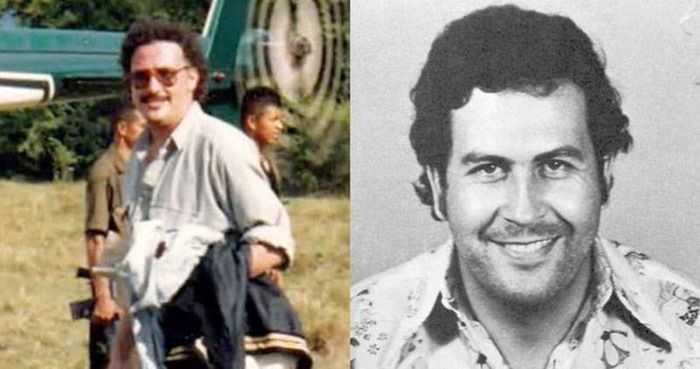General Facts and Figures
- Full name: Javier Peña
- Net Worth: $1 Million to $5 Million
- Education: Texas A&I University (now known as Texas A&M University–Kingsville)
- Occupation: Former Drug Enforcement Administration agent
- Birthday: Unknown
- Birthplace: Kingsville, South Texas
- Birth Sign: Unknown
- Spouse: Unknown
Trivia
- As shown on the television series Narcos, Peña never worked with the terrorist organization known as the Los Pepes.
- Peña and Steve Murphy (the other DEA agent involved in drug kingpin Pablo Escobar’s hunt) appear as themselves in the last episode of the second season of Narcos.
- Also, Peña had absolutely no role in the Cali Cartel operation, as season 3 of Narcos suggested. Peña left Colombia after Pablo Escobar was killed.
Highlights
Peña is part of the DEA agent duo (the other being Steve Murphy) who took down drug kingpin Pablo Escobar between the late 80s and early 90s, and their story became the basis of the very popular Netflix series Narcos.
When Peña joined the DEA, he applied to be a part of a team in Mexico (also partly because he is of Mexican descent), but because of a clerical mistake, he was assigned to Colombia. By 1988, Bogota, Colombia, was already becoming a major hub for the cocaine trade, and he was charged with the investigation of the Medellin Cartel.
Murphy joined him 4 years later from Miami. The cartel was already the largest organization dealing in cocaine, and its leader, Pablo Escobar, had made a name for himself across the Caribbean. Around this time, he was still little known in the United States.
For Peña, Escobar became a sort of “personal” project, where he tried to trace and understand the druglord’s hold over the South American country, and he studied Escobar and his methods in depth.
Peña has described the period he and Murphy spent in Colombia as “violent” and “chaotic,” and has called Escobar the “inventor of Narcoterrorism,” and when torture, murder, and corruption were most commonplace in the country.
After the capture and killing of Escobar on December 2, 1993, Peña and Murphy were flooded with offers from filmmakers who wanted them to tell the world their story. But the duo resisted, always fearing that the life of Escobar was already glamorized and the filmmakers would end up glorifying it further.
Peña and Murphy had been giving presentations to other law enforcement agencies before their retirement in 2013 when they were approached by producer Eric Newman for a possible Netflix series (Narcos). After initially refusing, Javier Peña and Murphy agreed to act as consultants for the first two seasons when they realized Newman didn’t want to glorify Escobar.
The Escobar Years
By the time Peña was stationed in Colombia, the country was in Escobar’s terrorist grip. Escobar virtually had a free run; he was bribing or blackmailing any judge who would have a case against him, killing police officers and setting off car bombs that killed dozens. Drug traffickers were everywhere and doing what they wanted, to ensure the daily exports of hundreds of kilos of cocaine.
Luis Carlos Galán would succeed in his campaign for Escobar’s extradition to the United States, so he ordered Galán’s execution.
And it did not stop there. After Galán’s murder, he ordered another hit on César Gaviria, who had been Galán’s debate chief and the next presidential candidate. To do so, his hitmen planted a bomb on Avianca Flight 203, which Gaviria was supposed to be on. Gaviria missed boarding the flight by mere minutes, but the bomb exploded mid-air, killing all 107 passengers.
After Gaviria was elected president, Escobar, knowing that the new president would do virtually anything to put an end to the violence and terror, offered to surrender — but on his own terms. And just days before the president and Escobar reached an agreement, Peña’s partner Murphy arrived in Colombia, in June 1991. The deal surprised and angered the DEA agents, as well as the local law enforcement, the Colombian National Police.
The drug lord had landed the deal of a lifetime: just so that the Colombian government would not extradite him, he agreed to serve 5 years in a prison that he had built to his own specifications. The “prison,” called “La Cathedral,” was built on a foggy mountainside to keep the kingpin and his henchmen undercover, and had all the modern amenities seen in hotels (it was also referred to as “Hotel Escobar” or “Club Medellin”).
The prison had a pool with a waterfall, a jacuzzi, an industrial kitchen, a billiard room, several bars, saunas, several big-screen TVs, and even a disco where Escobar allegedly held several wedding receptions. Naturally, there was outrage over it, with people calling it an “insult to the memory of the loved ones” they had lost in the drug war.
After a lot of pressure from many lobbies, the Colombian government finally ordered that Escobar be shifted to a regular, high-security prison, a year after he had “surrendered.” Naturally, Escobar escaped, but the government agencies and the DEA were hot on his trail this time.
Peña and Murphy were very persistent in their search, as is accurately depicted in the series Narcos and arrived on the scene just minutes after Escobar has made his escape several times. Escobar had enjoyed “goodwill” among many people, portraying himself as a “Robin Hood” figure, and had help, but that too was changing rapidly.
Escobar went on to be on the run for about 16 months, with the DEA and the law enforcement close on his trail. The week he was killed on a rooftop after a brief chase by the police, Peña was ordered to fly to Miami, where he was supposed to meet an informant who had claimed that Escobar was in Haiti.
Even today, 26 years after Escobar was killed, Peña and Murphy continue to argue against the influence and the legacy he left behind.
Awards and Accolades
Peña is regarded as a leading expert on the Medellin Cartel, and apart from receiving several recommendations from his agency, the DEA, he has also been conferred the highest honor for his efforts in the “War on Drugs.”
Personal Life
Peña started his DEA career in 1984, where he worked undercover. Part of his job was to infiltrate gangs that sold LSD in Austin, around the University of Texas campus. Having seen the drug trade up-close (he even had to buy heroin on occasion), Peña wanted more. Before the start of his DEA career, Peña had worked as a deputy sheriff in Laredo, Texas.
Following his stint in Colombia, Peña remained a DEA agent. He was posted around the world in this capacity, including in Texas and Puerto Rico, and one more time in Colombia. He also served as the special agent in charge in Houston. After his retirement in 2014, he currently lives in San Antonio, Texas. He signed on as a consultant for Narcos in 2015.
He has always maintained that the real heroes in the Escobar investigation were the Colombian National Police. He does regular speaking tours with Murphy to talk about what really happened in Colombia in those days and the rise and fall of the Medellin Cartel.
Retired
He retired in January 2014. Peña co-authored the 2019 book Manhunters: How We Took Down Pablo Escobar with Steve Murphy.
How realistic is Narcos?
Even though Narcos is a dramatization, Newman told THR that the series is a 50/50 mix of fiction and reality and that it follows the real order of events. Pena says, “We told them how it really went down.” “The author took some creative liberties, but the timeline is right.”



